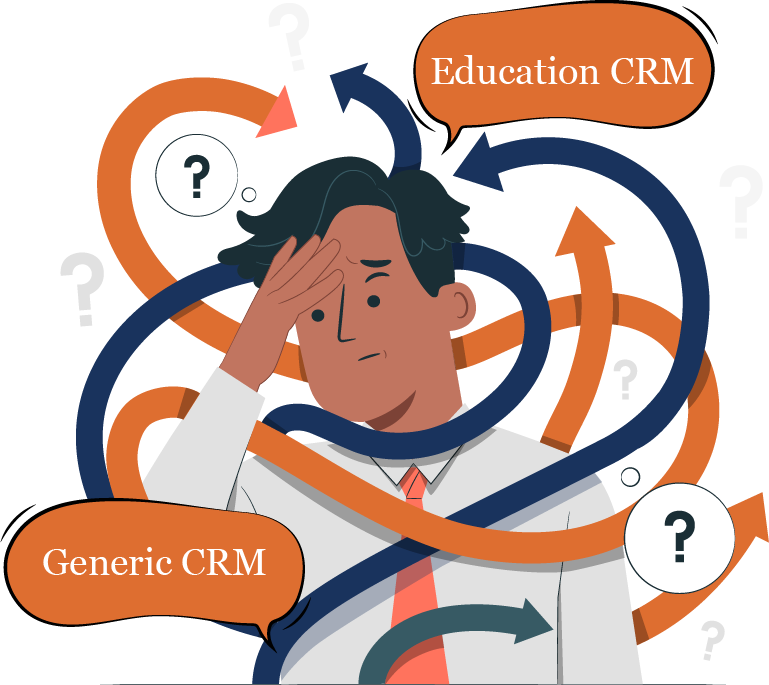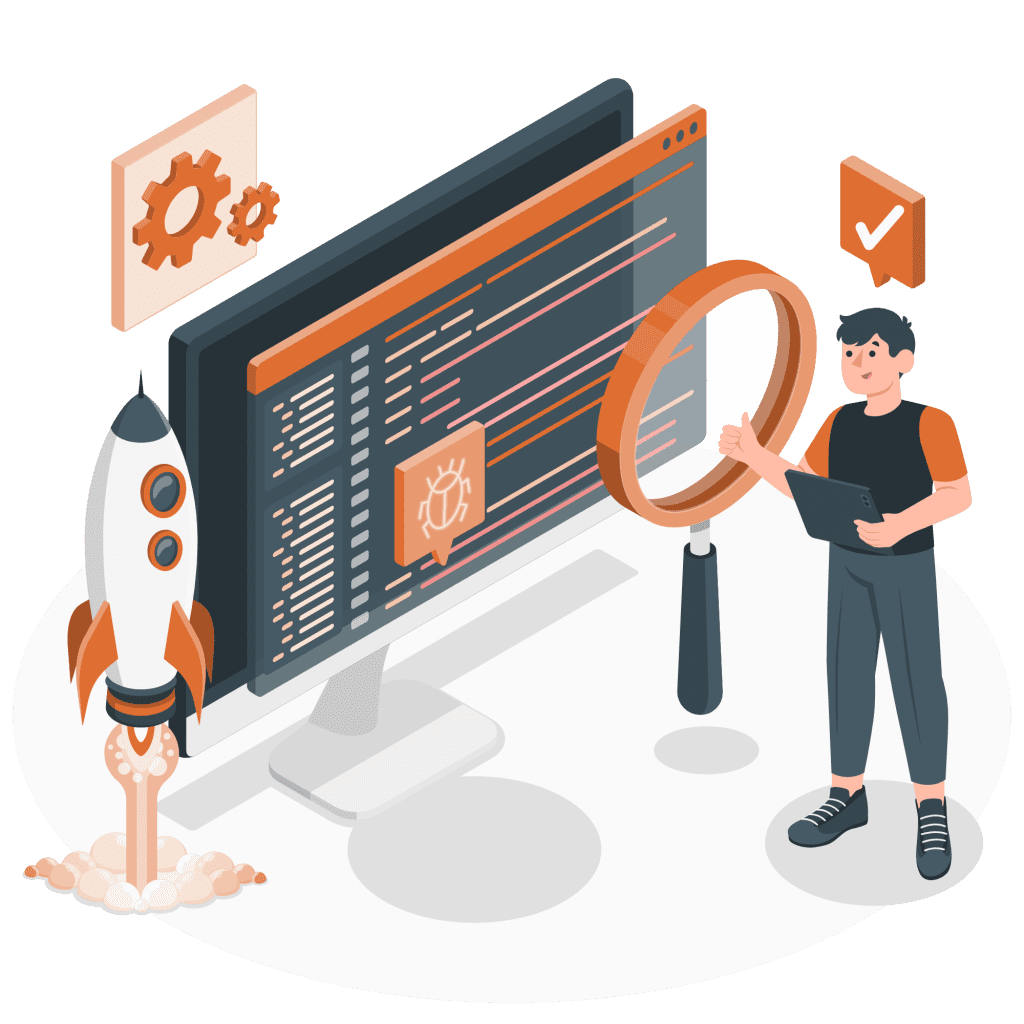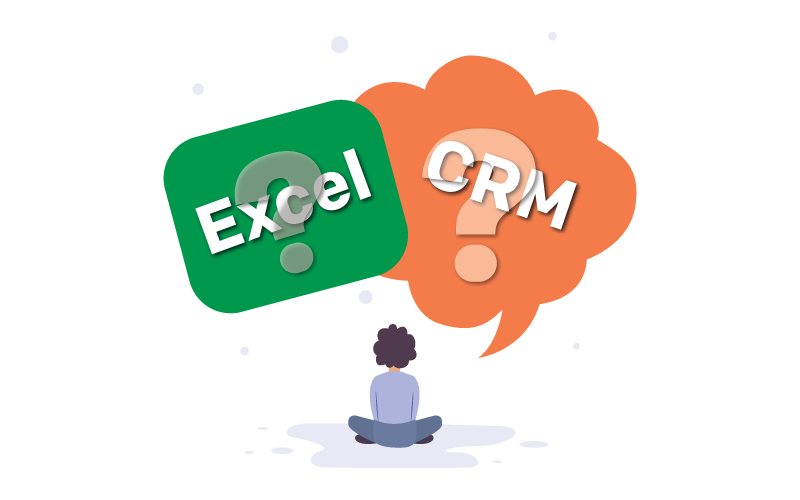A Guide to Choosing the Best Education CRM

If you ever wondered what CRM systems are and how to choose the best to meet your admissions needs, this article is for you.
CRMs have a strong presence in every booming industry, as they require a system that assists them with operations and analytics. The adoption rate of CRM in various industries is exceptionally high.
- Retail: 91%, the highest in any industry.
- Technology: 87%
- Manufacturing: 78%
- Business services: 76%
- Media and entertainment: 74%
It is evident that these industries are embracing CRM as a technological friend in their growth journey.
But the scenario is not so bright in the education industry. According to a study by Meritt, only 50% of educational institutions are using CRM software. The adoption rate is higher in higher education, with 60% of colleges and universities using CRM software.
The reasons for this slow adoption among the education institutes are:
- Transitional Dillema:
The first question that arises when considering streamlining your admissions process is whether to continue using familiar Excel sheets or transition to a CRM system.
- Confusing Choices:
The second, and often most challenging, phase of the transition involves selecting a CRM system that can fully cater to your specific needs.
- Regrettable Choices:
The third phase, often dreaded, is making the wrong choices in selecting a CRM system. This can lead to significant financial, time, and resource losses.
This blog is meant to assist you in the above two aspects and prevent you from entering the third one, so do read the entire article.
Why transfer from Excel to CRM?

The first version of Excel was released in 1985, so it has been around for 38 years. It has become a ubiquitous tool for businesses and individuals alike and is used for a variety of tasks, including data analysis, financial modelling, and creating charts and graphs.
No way around it, we can deny the fact that Excel has sorted our lives to a great extent, but as nothing is 100, Excel has its own limitations. If we talk specifically about the education institutes, then Excel sheets are not enough; they need more than the pivot tables. Maybe a CRM that is specifically designed for them!
To learn more about how an Education CRM can ease your institute’s admissions journey, let’s take a look at:
Benefits of using an education CRM

- Streamlined Admissions Process: CRM systems can significantly streamline the admissions process. You can automate tasks such as application tracking, document collection, and follow-up communications, reducing administrative workload and minimizing the chances of errors. This efficiency will result in quicker decision-making and a more seamless experience for both applicants and admissions staff.
- Data Analytics and Reporting: CRM software provides robust data analytics and reporting capabilities. Educational institutions, like you, can use these tools to gain insights into student demographics, enrollment trends, and the effectiveness of marketing campaigns. This data-driven approach allows for more informed decision-making and helps institutions tailor their strategies for better results.
- Enhanced Communication: A CRM system facilitates better communication not only with prospective and current students but also with alumni and other stakeholders. Automated email campaigns, personalised messaging, and integration with communication platforms enable institutions to maintain strong connections with their entire community.
- Automated Lead Allocation: Educational institutions can efficiently assign admissions counsellors to prospective students based on factors like academic interests and location, enhancing the personalized support offered during the admissions process.
- Integration with Other Systems: Many CRMs can integrate with other essential software systems commonly used in education, such as learning management systems (LMS), financial management software, and student information systems (SIS). This integration ensures data consistency and a more comprehensive view of student information.
- Scalability: As your educational institution grows, a CRM can scale with you. Whether you’re a small college or a large university, a good CRM system can adapt to your changing needs and accommodate an expanding student body.
- Data Security and Compliance: Education CRM systems typically prioritize data security and compliance with regulations like the Family Educational Rights and Privacy Act (FERPA). This ensures that sensitive student information is protected and that institutions remain in compliance with relevant laws.
- Enhanced Marketing and Recruitment: CRMs enable targeted marketing efforts by segmenting prospective students based on various criteria. This helps institutions reach the right audience with tailored messages, ultimately improving recruitment outcomes.
- Cost Savings: While there’s an initial investment in implementing a CRM system, the long-term benefits often outweigh the costs. By automating tasks, reducing manual labour, and improving efficiency, educational institutions can realize cost savings in various areas.
Doesn’t this system have the potential to make your admissions numbers look significantly better?
But how will you find the perfect education CRM for your institute?
Don’t worry; we are here to answer this question very briefly, making it less confusing for you. Let’s simplify the process of finding the perfect CRM for your institute.
Just keep these key points in mind during your CRM search, and you’ll navigate the selection process with confidence.
What should I look for while choosing an education CRM?

- Customization and Flexibility: Ensure that the CRM system allows for customization to meet the unique needs of your educational institution. Look for a solution that can adapt to your specific workflows, processes, and data requirements.
- User-Friendly Interface: The CRM should have an intuitive and user-friendly interface to facilitate easy adoption by staff members. Training requirements should be minimal to maximize efficiency.
- Integration Capabilities: Check if the CRM can seamlessly integrate with your existing systems, such as your student information system (SIS), learning management system (LMS), and financial management software. Integration ensures data consistency and efficiency.
- Scalability: Consider your institution’s future growth. The CRM should be scalable to accommodate an increasing number of students, staff members, and data without significant disruptions or additional costs.
- Data Security and Compliance: Ensure that the CRM prioritizes data security and compliance with relevant regulations, such as FERPA. It should provide robust access controls and encryption features to protect sensitive student information.
- Reporting and Analytics: Look for a CRM with powerful reporting and analytics capabilities. It should offer a range of pre-built reports and the ability to create custom reports to gain insights into student demographics, enrollment trends, and campaign effectiveness.
- Communication Features: Evaluate the CRM’s communication tools, including email automation, personalized messaging, and communication platform integration. Effective communication is essential for building strong relationships with students, alumni, and other stakeholders.
- Mobile Accessibility: In today’s mobile world, having a CRM with mobile accessibility is crucial. This allows staff to access and update information on the go, ensuring timely responses to inquiries and tasks.
- Support and Training: Consider the level of support and training provided by the CRM vendor. Adequate training and ongoing support can help your institution make the most of the CRM’s features.
- Cost and ROI: Assess the total cost of ownership, including implementation, licensing, and ongoing maintenance costs. Compare this with the expected return on investment (ROI) in terms of efficiency improvements, cost savings, and increased enrollments.
- User Feedback and Reviews: Research user feedback and reviews from other educational institutions that have implemented the CRM. Their experiences can provide valuable insights into the system’s strengths and weaknesses.
- Vendor Reputation: Choose a reputable CRM vendor with a track record of success in the education sector. Consider factors such as the vendor’s experience, customer support, and commitment to product updates and improvements.
Closing Thoughts: CRM as a Tech Evolution
The world of education is evolving rapidly, and the adoption of the right education CRM can be a transformative step for your institution. By making a thoughtful choice and considering the key factors mentioned above, you can pave the way for more streamlined admissions processes, enhanced student engagement, and improved admission numbers.
So, take the leap, explore the options, and find that perfect education CRM that aligns seamlessly with your institution’s unique needs and aspirations. Embrace technology as your partner in the journey toward a more efficient, data-driven, and student-centric future. Your institution’s growth and success may very well depend on it.
PS: We’ve been helping educational institutions for years and understand that each one is unique. Our platform is all about customization, designed to fit your specific needs.
We’d love the chance to show you our top-notch education CRM, a tool that can make a real difference for your institution. Let us demonstrate how it can work for you by booking a 30-minute demo with our admissions expert.


